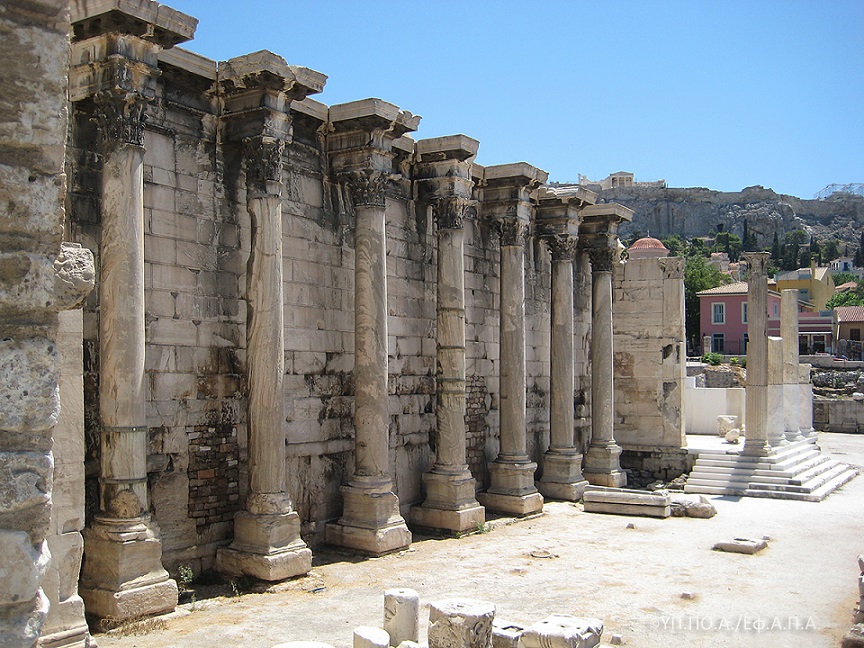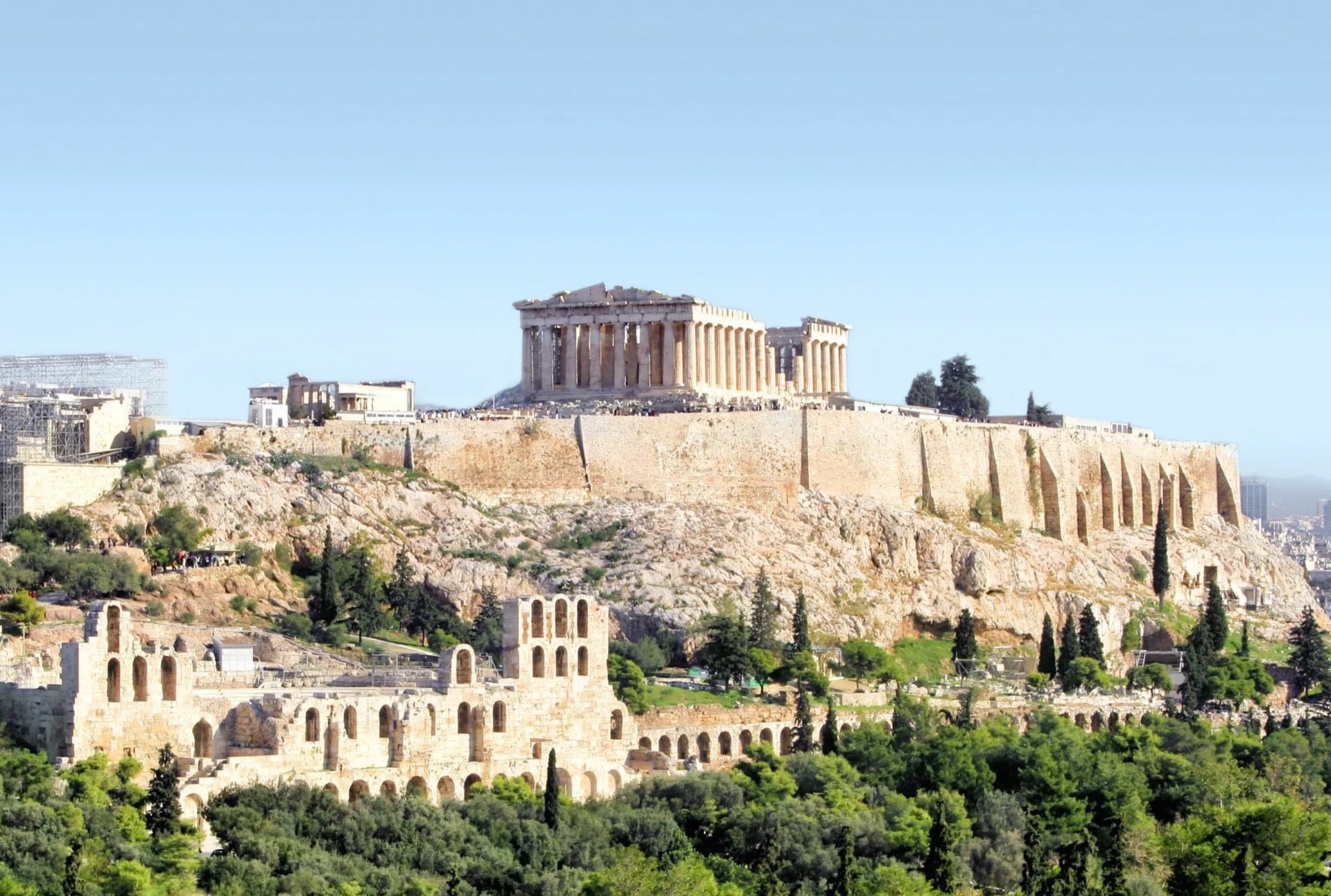
Hadrian's Library
Attica & Central Greece
The magnificent building of the Library was built during the third visit of Emperor Hadrian in Athens during 131-132 A.D. The Library was a rectangular peristyle structure with interior courtyard [122X82m.] with four stoas one on each side. It had only one entrance through a monumental gateway, propylon on its western side, with four Corinthian order columns of Phrygian marble. Alongside the propylon on each side a marble wall was erected with seven columns of Corinthian order from Karystian marble. According to Pausanias travelogues the Library had on the interior a large oblong cinstern, one hundred columns of phrygian marble on each stoa and rooms decorated with alabaster roofs and paintings. In the central two-storey building of the eastern side, inside niches and wooden cupboards the books and papyrus was kept while on each corner of the same side a small lecture halls [auditoria] was built.
The form and the uses of the place which served as a place of art exhibition, lecture and also for the worship of the emperor and as a place of safekeeping the archive of the city allows us to interpete it as a multifunctional building or as imperial forum according to the well known other forum buildings of Rome.
The Library suffered severe damages from the Herulian invasion in A.D. 267, and it was later repaired by Herculius the Perfect of Illiricum [AD 407-412].
In the early 5th century AD, in the area of the interior courtyard of the Roman monument, an imposing tetranconch church with an atrium was built on its western side. This tetranconch church was destroyed in the late 6th century A.D. and converted in the second half of the 7th century A.D. into a three-aisled basilica. Atop its ruins there was built in the 11th century A.D. a Byzantine church known as the church of Megali Panaghia, which was demolished in 1885.
In the 12th century A.D., the Chalkokondylis family built a small church which was dedicated to Saint Asomatos [the Archangel Michael] adjoining part of the facade and the propylon of the Library. The church was demolished in 1843 and the only visible remains of the church are a wall and a wall painting on the LibraryЮs facade with depictions of the prayer at Gesthemane, Judas Betrayal of Christ and portraits of saints in bust form.
In the North, by the Pandrosou street.
In the West, by the Areos street where the main entrance of the site is located.
In the South, by Dexippou street where the entrance with immobility affairs is located.
In the East, by Aiolou street.
The form and the uses of the place which served as a place of art exhibition, lecture and also for the worship of the emperor and as a place of safekeeping the archive of the city allows us to interpete it as a multifunctional building or as imperial forum according to the well known other forum buildings of Rome.
The Library suffered severe damages from the Herulian invasion in A.D. 267, and it was later repaired by Herculius the Perfect of Illiricum [AD 407-412].
In the early 5th century AD, in the area of the interior courtyard of the Roman monument, an imposing tetranconch church with an atrium was built on its western side. This tetranconch church was destroyed in the late 6th century A.D. and converted in the second half of the 7th century A.D. into a three-aisled basilica. Atop its ruins there was built in the 11th century A.D. a Byzantine church known as the church of Megali Panaghia, which was demolished in 1885.
In the 12th century A.D., the Chalkokondylis family built a small church which was dedicated to Saint Asomatos [the Archangel Michael] adjoining part of the facade and the propylon of the Library. The church was demolished in 1843 and the only visible remains of the church are a wall and a wall painting on the LibraryЮs facade with depictions of the prayer at Gesthemane, Judas Betrayal of Christ and portraits of saints in bust form.

From 1st of April until 31 of August 08:00 - 20:00
Last entrance to the Site at 19:30
On the 1st of September the opening hours apply, due to a gradual reduction in the length of the day, as follows:
1st to 15th September 08:00 - 19:30
Last entrance to the Site at 19:00
16th to 30th September 08:00 - 19:00
Last entrance to the Site at 18:30
1st to 15th October 08:00 - 18:30
Last entrance to the Site at 18:00 and
16th to 31st October 08:00 - 18:00
Last entrance to the Site at 17:30
Last entrance to the Site at 19:30
On the 1st of September the opening hours apply, due to a gradual reduction in the length of the day, as follows:
1st to 15th September 08:00 - 19:30
Last entrance to the Site at 19:00
16th to 30th September 08:00 - 19:00
Last entrance to the Site at 18:30
1st to 15th October 08:00 - 18:30
Last entrance to the Site at 18:00 and
16th to 31st October 08:00 - 18:00
Last entrance to the Site at 17:30
Click here to locate the Site on map
The archaeological site to be visited is delimited by the following streets:In the North, by the Pandrosou street.
In the West, by the Areos street where the main entrance of the site is located.
In the South, by Dexippou street where the entrance with immobility affairs is located.
In the East, by Aiolou street.
The Archaeological Site of the Library of Hadrian is only partially wheelchair accessible through the lateral entrance, at Dexippou street [assistance by a companion is advisable and after communication with the chief guards in 210-3210180].You can see the accessible passage at:
http://theheartofancientathens.gr/wordpress/wp-content/uploads/2019/07/Efaath_AncientAgora_accessibility.jpg
The site of the Library of Hadrian is fully accessible to visitors with reduced mobility and wheelchair users. A WC for the physically challenged is also provided.
At the ticket desk of the site, tactile site plans and brochures in Braille in Greek and English are available for visually impaired visitors.
A guide for visitors on the autism spectrum is available at the internet site of the Ephorate: https://efaathculture.gr.
Moreover, our internet site presenting the Archaeological Sites that have been awarded the European Heritage Label http://theheartofancientathens.gr, is fully accessible to blind and partially sighted people in Greek, English, French, German, Italian and Spanish.
http://theheartofancientathens.gr/wordpress/wp-content/uploads/2019/07/Efaath_AncientAgora_accessibility.jpg
The site of the Library of Hadrian is fully accessible to visitors with reduced mobility and wheelchair users. A WC for the physically challenged is also provided.
At the ticket desk of the site, tactile site plans and brochures in Braille in Greek and English are available for visually impaired visitors.
A guide for visitors on the autism spectrum is available at the internet site of the Ephorate: https://efaathculture.gr.
Moreover, our internet site presenting the Archaeological Sites that have been awarded the European Heritage Label http://theheartofancientathens.gr, is fully accessible to blind and partially sighted people in Greek, English, French, German, Italian and Spanish.

